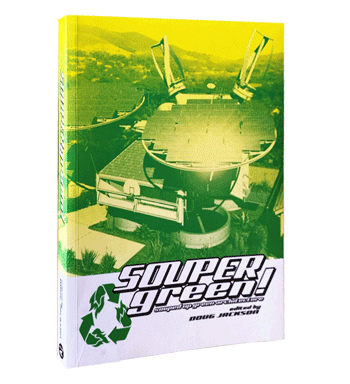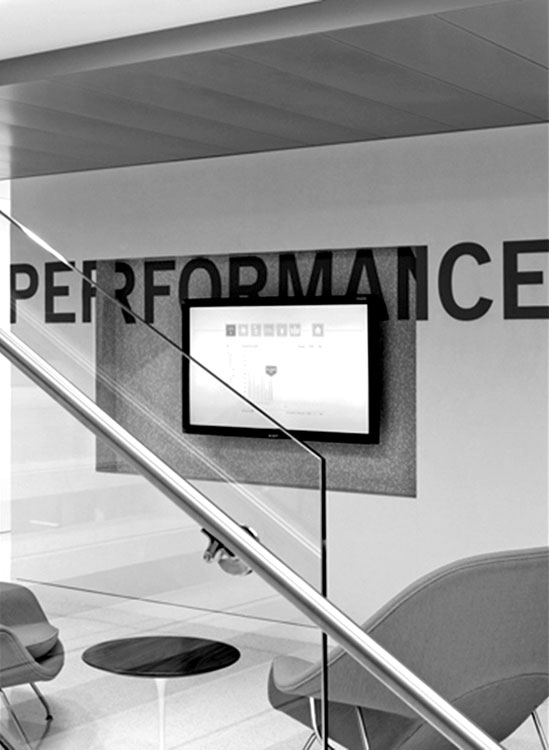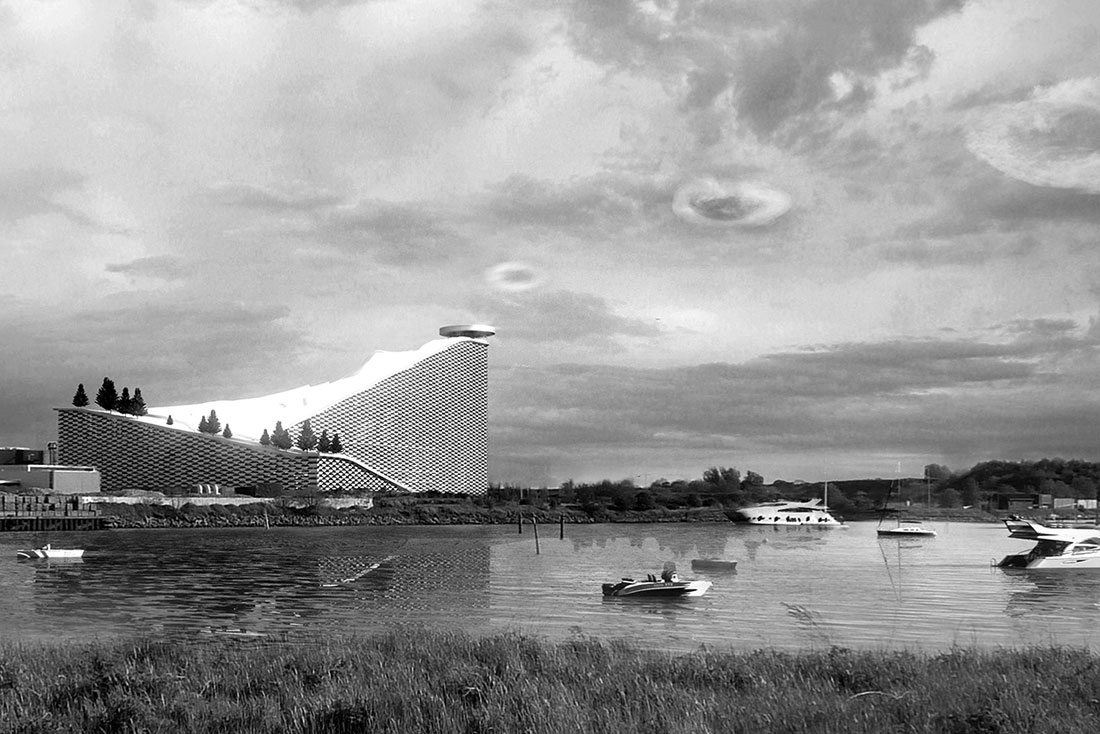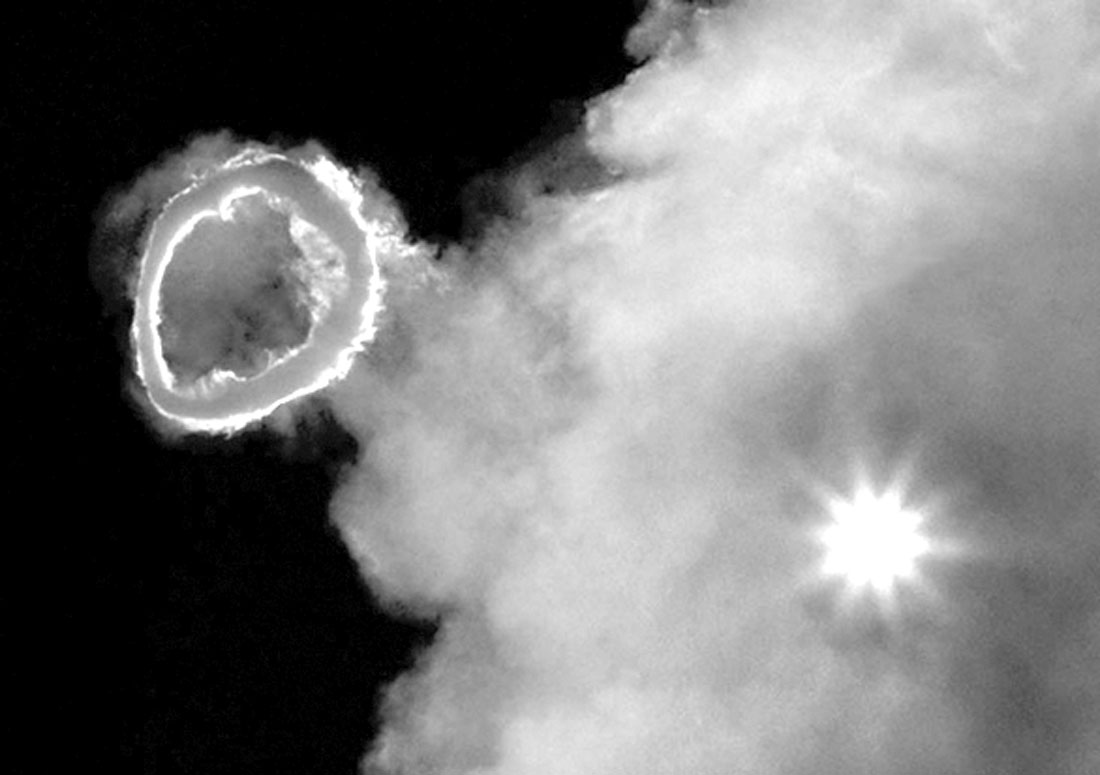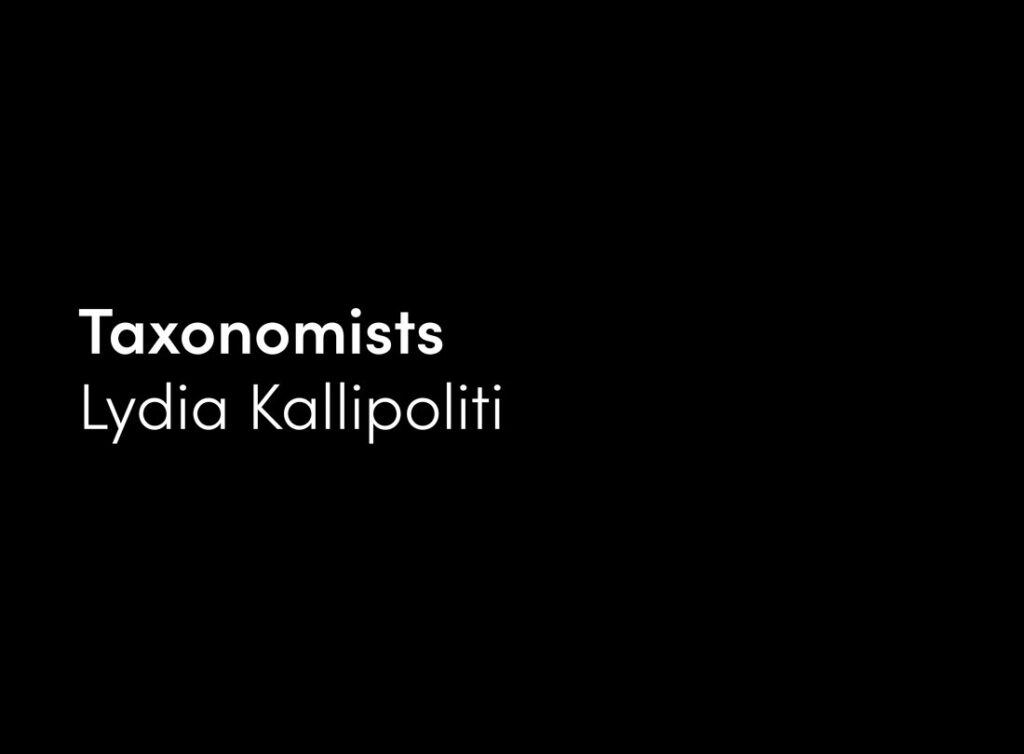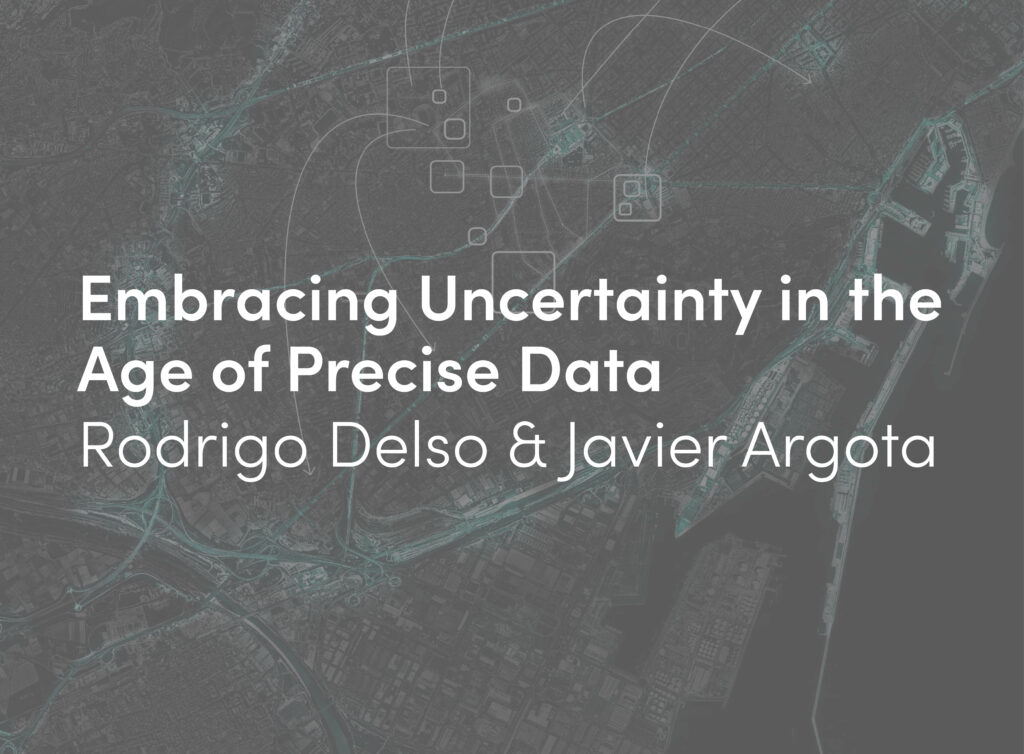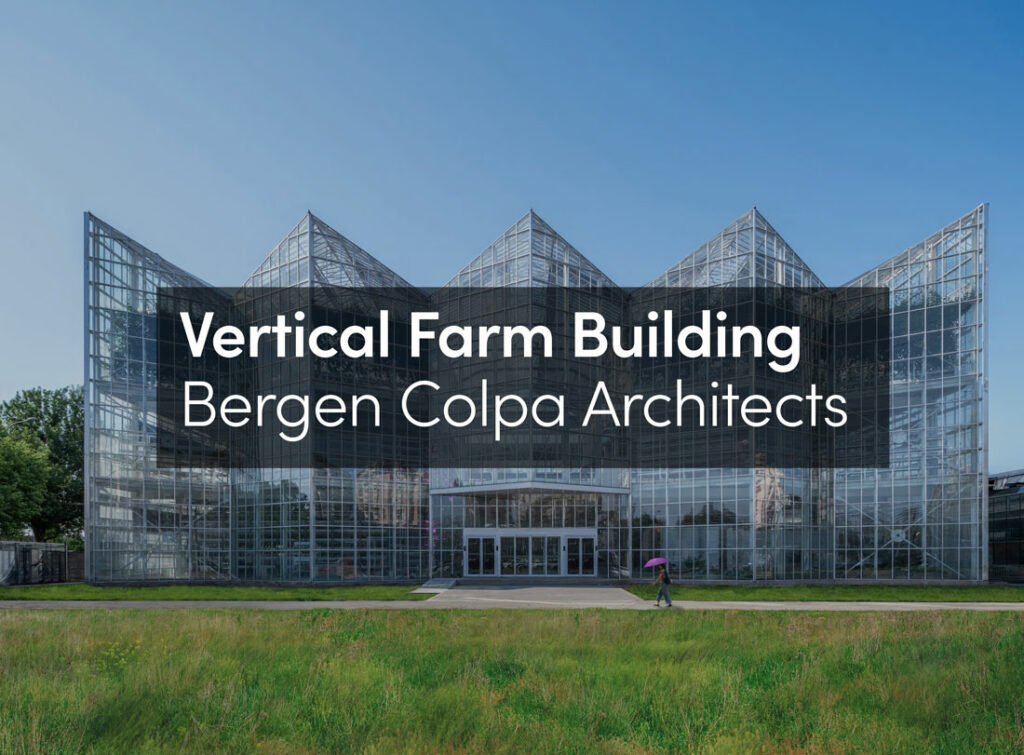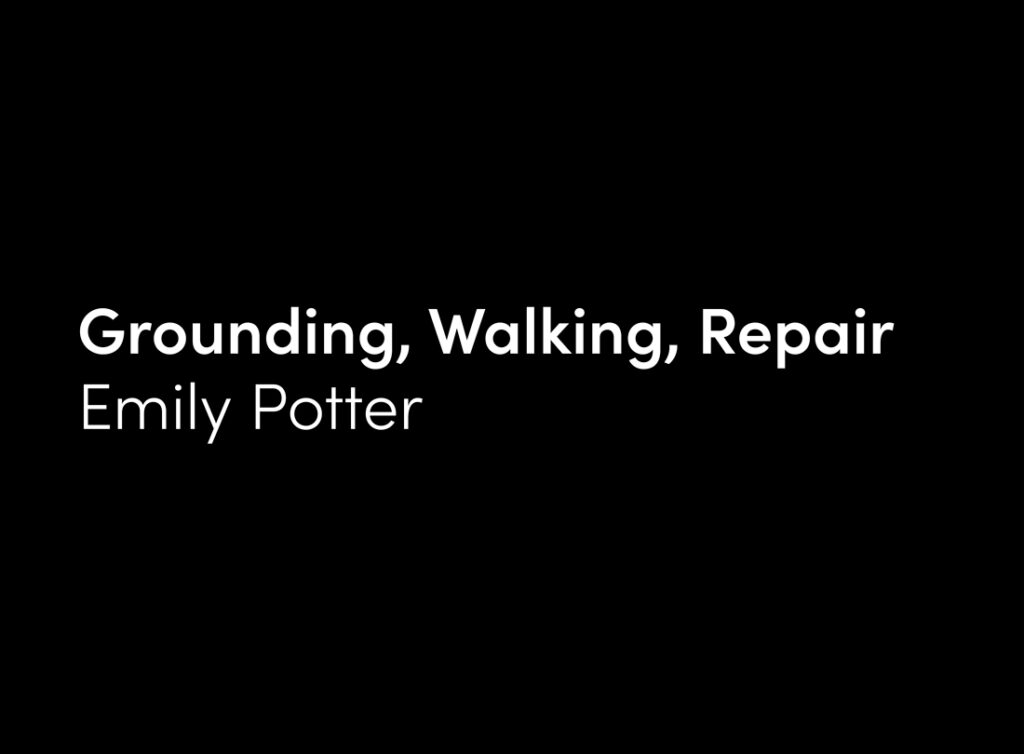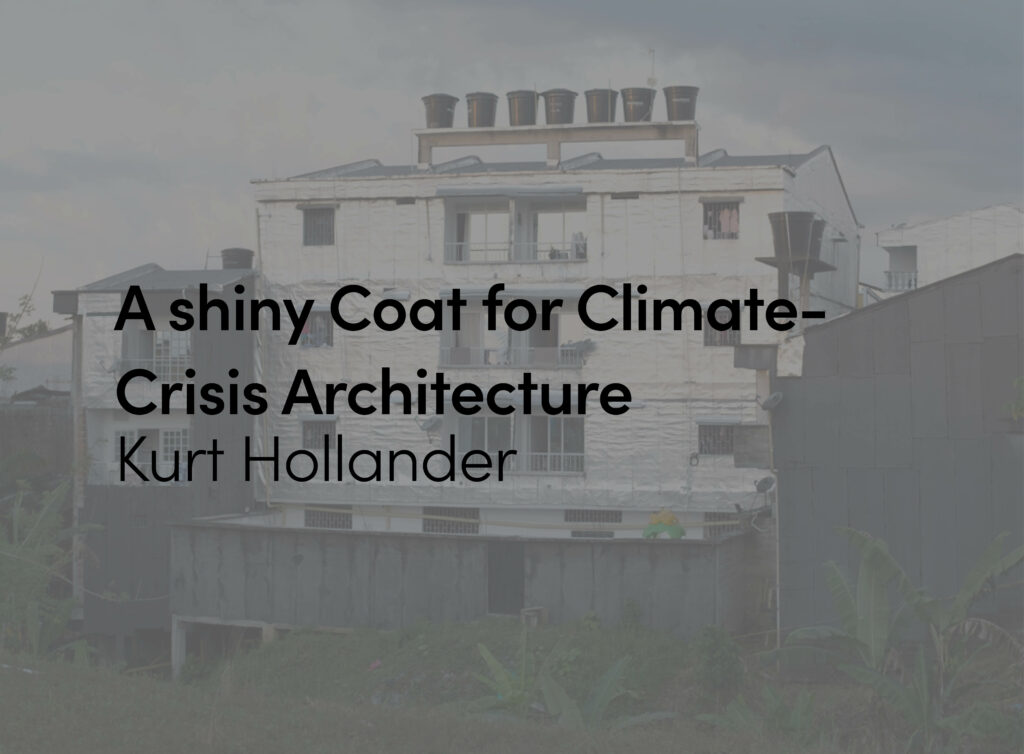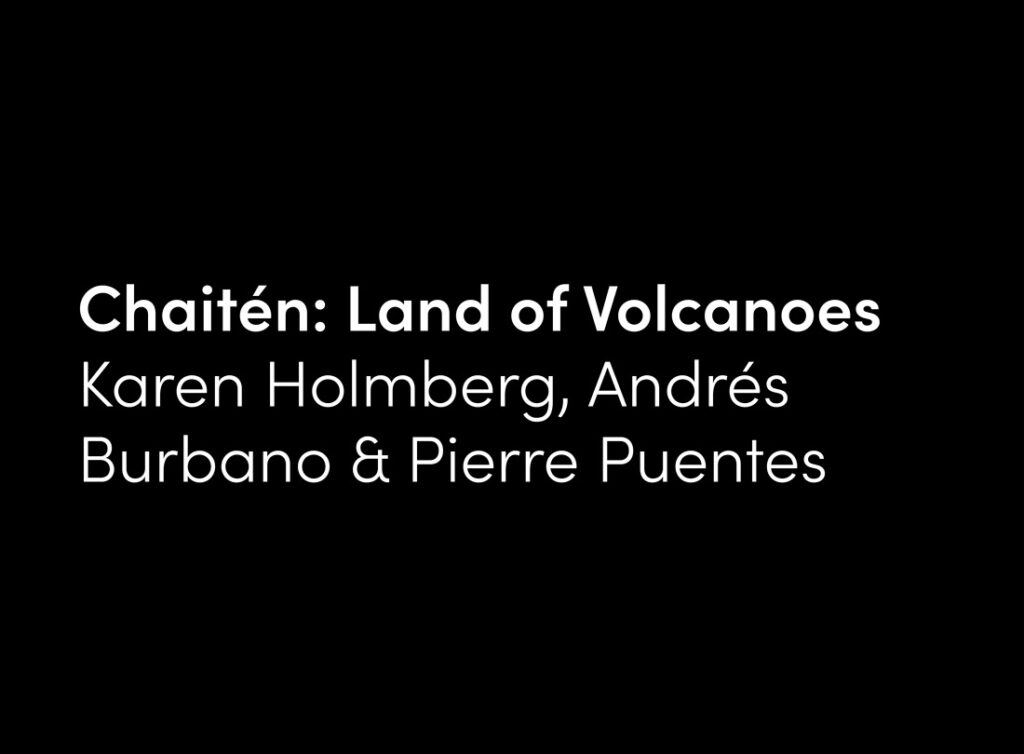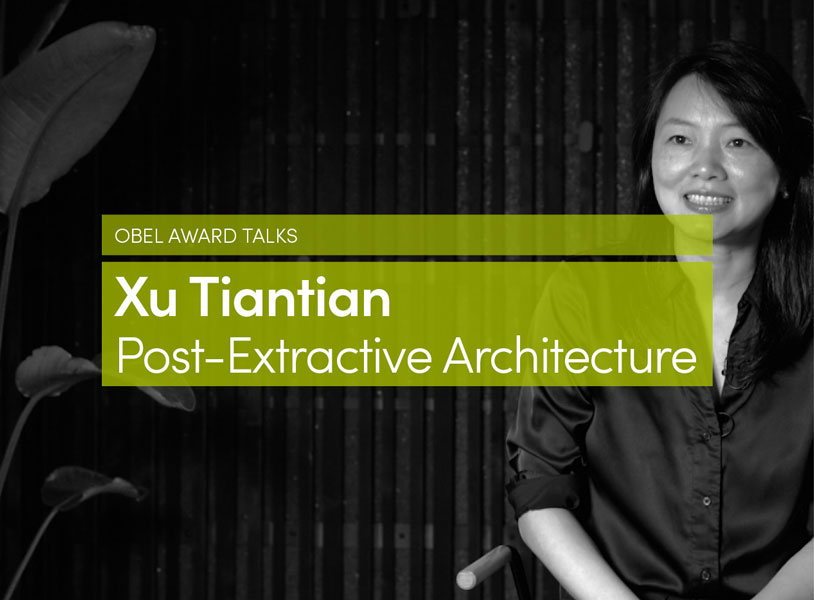It’s not easy being green It seems you blend in with so many other ordinary things
And people tend to pass you over
‘Cause you’re not standing out
Like flashy sparkles in the water
Or stars in the sky —Kermit the Frog [1]
The frog is right: it’s not that easy being green—although we are constantly being led to believe that it is. Millennia of human technological civilization have hardwired into our brains an unfailing confidence in our perception of the natural world, as well as in the ability of technology to easily intervene on our behalf in order to ensure our comfort and security—and, when necessary, to ameliorate or repair any damage we may cause in the process. In addition, while the past decades have seen an increasingly extensive campaign of information directed at the public detailing the seriousness of the environmental crisis, there has also been a parallel campaign by a burgeoning green industry of newly available technologies and products marketed to this public—products that prey upon individual consumers’ dual desires to both make a positive environmental impact and to do so with a minimum impact to their daily lives. [2] Accordingly, many such “green” products and technologies either overtly or implicitly extol their very ordinariness—implying that their everyday and familiar qualities will make them more broadly and easily acceptable. Meanwhile, the architectural discipline has adopted a similar strategy with respect to its own work—relying on the agency of technologies that achieve measurable environmental performance on our behalf, but which are otherwise so unremarkable that they fail to cultivate a necessary doubt or hesitation about our conception of the natural world and our habits and behaviors with respect to it.
These conditions have conspired to frame the environmental crisis as a large, but otherwise relatively ordinary, problem with a correspondingly easy technological solution. However, the apparent easiness of such efforts is contrary to the actual difficulty of the problem at hand. While these products and technologies are commendable in their aspiration to have a meaningful environmental impact, their cumulative effect is minor at best. The scope of humanity’s environmental degradation is so vast, and is fueled by such a deep-seated and long-standing anthropocentric misperception of the environment and humanity’s position within it, that such small moderating efforts do little more than distract from the enormity of the underlying perceptual problem.
So, as Kermit the Frog so presciently observed, the key problem with “greenness” is that it has become so ordinary when it should, in fact, be remarkable. The degree to which contemporary “green” practices, products, technologies, and even architecture conform to and sustain the status quo only serves to endorse an unconscious and uncritical relationship to the environment. This, in turn, leaves unexamined the three underlying and related aspects of contemporary human civilization which are the root cause of our unrelenting environmental degradation: our sense of distinction from the environment instead of continuity with it, the characterization of the planet as a resource for human exploitation, and our faith in science and technology to infallibly understand, control, and rectify the environment.
These three criticisms of humanity’s relationship to the environment form the basis of a branch of environmental philosophy known as Deep Ecology. Founded in the early 1970s by philosopher Arne Næss, Deep Ecology critiques the prevailing conceptual division between humanity and the natural world, wherein humanity is seen to be in an autonomous and superior position relative to all else, and which thereby frames the planet as a human resource. The term Deep Ecology was coined by Næss as a critical response to what he referred to as “shallow” forms of environmentalism that hew to this anthropocentric, dualistic, and resource-centered understanding of the environment—relying on responsible consumption and targeted technological intervention in order to conserve the resource value of the planet. [3] The contemporary principle of sustainability, which has come to monopolize the architectural discipline’s response to the environmental crisis, precisely embodies this latter “shallow” approach.
However, the Deep Ecologists’ pejorative labeling of sustainability and other similar approaches as “shallow” belies how deeply rooted the anthropocentric perceptions that underlie them really are. This fact is underscored by the problematic nature of the very language used to discuss these issues. Having as its root the Old French environ (“that which surrounds”), the term “environment,” for example, connotes an image of a centered human subject situated within, and distinct from, a surrounding context. Its usage, therefore, implicitly reinforces the dualistic and anthropocentric mode of thought that has directly contributed to humanity’s degradation of the environment. Even the term “ecology” is not without its etymological and connotative problems. Its stem, “eco,” derives from the Greek oikos (“house”), and implies the study of a stable and bounded space occupied by a human subject.
Both terms therefore reveal in their etymology that the human conception of the world is really just a limited representation of the world—one based on, and distorted by, the placement of humanity in a privileged position as its centered subject. Rather than an a priori context within which humanity exists, the world—variously described by terms such as environment, ecology, and nature—is actually an artificial, and fallible, conceptual framework. “That which we now call the world,” observed Friedrich Nietzsche, “is the outcome of a host of errors and fantasies.” [4] Environmental philosopher Neil Evernden further articulated that the concept of nature is itself “a mode of concealment” and a “conceptual imprisonment” that obscures the actual wildness of the world. [5] Nature, ecology, and environment are thus all erroneous appearances of the actual world as seen from the perspective of a very particular and limited space—an oikos—that humanity has constructed.
Martin Heidegger articulated how technology occupies the gap between appearance and actuality, as an instrument capable of causing certain ideas about the world to appear as if they actually constitute the world. With respect to the environment, Heidegger argued that modern technology, in particular, was not only an instrument of human will, but also instrumental in framing the natural world as a material and energy reserve (Bestand) standing ready for human exploitation. [6] Therefore, according to Heidegger, modern technology is not simply a means to an end, but also a means by which the world is perceived in accordance with those ends. In other words, as the saying goes, when all you have is a hammer, every problem looks like a nail. [7]
So-called “green” technologies are no different, insofar as their fundamental basis in quantifying resources and minimizing their consumption narrowly frames the environment, and humanity’s relationship to it, in only those terms: as a resource, with humanity as its consumer and responsible manager. It is this particular anthropocentric space, this version of the world framed by technology, which sustainability seeks to sustain. Greenness, moreover, has become simply a measure of congruency—of a supposedly “natural fit”—with this world.
But, for this reason, these concepts are insufficient. As historian Leo Marx observed, environmental technologies based on such measurement and quantification can only deal with the symptoms of environmental problems, rather than their underlying causes. Humanity’s ability to address those deeper issues, he argued, “will in large measure depend on less tangible, largely unquantifiable political, institutional, and cultural factors.” [8] Accordingly, what is needed instead is a fundamental reconceptualization of the planetary ecology and humanity’s position within it—what architectural historian Amy Kulper refers to as “an ecology without the oikos.” [9]
Radical forms of environmental philosophy, including not only Deep Ecology but also Social Ecology and Ecofeminism, have argued for just such a reconsideration—one in which the conceptual division between humanity and environment is collapsed. However, none of these philosophies sufficiently identify the spatial and technological dimensions of this conceptual problem—nor do they articulate spatial and technological strategies that might address it.
Architecture, of course, has the ability to do so. In fact, of all of the disciplines being brought to bear on the ecological crisis, it is uniquely suited to do so, given its nature as a spatial technology directed at the production of world-like environments. To date, however, this unique ability has been abandoned in favor of the production of either relatively superficial formalist work that is merely suggestive of environmental engagement, or else work that is so technologically pragmatic in nature that its engagement with the environment is unremarkable at best. Both approaches are, sadly, indicative of a discipline that no longer truly believes in its ability to contribute value to society through critical forms of spatial production. To finally make a meaningful difference, therefore, architecture first needs to regain its mojo.
Easy Greenness
Architecture engages both the ideological arena and that of the marketplace—lending its ear, as it were, to an angel on one shoulder and a devil on the other. In its role as a critical spatial practice it could, therefore, elect to tackle the fundamental ideological problem at the root of the environmental crisis by creating spaces that reframe humanity’s relationship to the natural world. Yet, as a discipline, architecture is continually challenged to assert its value to an evolving culture, and its ability to do this through a critical engagement with ideological issues has suffered as society and culture have become increasingly ideologically diverse. Furthermore, the “post-critical” faction within the discipline, by parlaying this unfavorable condition into a polemical devaluation of architecture’s critical efforts, has hampered the discipline’s ability to assert a value for its works that differs from those values already established by the marketplace: economy, efficiency, technological sophistication, and measurable performance.
With respect to so-called “green” architecture, this has led to a form of evaluation focused narrowly on measurable performance criteria, as embodied in the Leadership in Energy and Environmental Design (LEED) certification program sponsored by the U.S. Green Building Council. This program assesses a building’s performance based on points accrued through various design criteria, with a heavy emphasis on the specification of products and technologies that reduce annual energy usage. [10] Accordingly, architecture has adopted the green movement’s emphasis on new products and technologies, and has therefore framed its primary role as both an innovator of and showcase for these new technologies within the building industry. However, these products and technologies are for the most part either invisible (as in the case of various high-performance HVAC systems, insulation, and other such materials integrated into walls, floors, and ceilings) or are designed to be indistinguishable from the lower-performance products they replace.
The U.S. Green Building Council (USGBC) Headquarters in Washington D.C. is a typical example of this approach. Featured, among other places, in the June 2009 issue of Metropolis magazine, which has a cover emblazoned with a tagline about the project: The real future of green—take a generic building and turn it into a showcase for sustainable design, the USGBC Headquarters aspires to demonstrate how similar to a conventional corporate office it can be, rather than how it might distinguish itself from such generic examples. [11] The coverage of this building in Metropolis is notable because, in addition to reviewing the design of the project itself, the author also describes the client’s and architect’s struggle to determine how the building’s identity might best serve the larger mission of promulgating sustainable design. Rather than choosing to foreground and dramatize its engagement with the environment, the client and architect opted for an approach based on stealth—having decided that the best way for sustainable design to succeed is through its adoption by corporate clients and developers, who they reasoned might be wary of any strategy that strayed too far from the norm. Rather disappointingly, therefore, the USGBC’s president demanded that their new headquarters be what Metropolis emphatically describes as “corporate—very corporate.” If this sounds like a weary, white-collared version of James Bond’s iconic introduction, “Bond, James Bond,” then perhaps that is not entirely inappropriate. After all, much like the tuxedoed secret agent’s efforts to seamlessly blend in with a party of high rollers at a card table while secretly possessing an array of clever technologies carefully concealed in such everyday items as pens and cigarette lighters, the USGBC Headquarters expertly mimics the slick but commonplace aesthetic of a contemporary corporate office interior, and in so doing betrays no hint of its manner of environmental engagement. However, even this analogy risks suggesting that there is more intrigue to the USGBC offices than there really is, since its various environmental technologies lack the drama and memorable cleverness of Bond’s laser wristwatches or cigarette guns. Instead, the list of features in the USGBC Headquarters includes such unassuming examples as auto-dimming fluorescent lights and automatic solar shades, as well as a mix of additional low-carbon design solutions that include the use of recycled materials and efficient office planning strategies. While well intentioned, such an approach is ultimately disappointing in its failure to acknowledge that environmentally responsible design might actually be hindered by such an innocuous and normalized deployment of environmental technologies, and that it might instead benefit from technologies and applications that afford a more conscious, dramatic, and phenomenal engagement with the environment. In contrast, one’s primary “engagement” with the USGBC building’s features could not be any less dramatic: a single flat screen display panel in the lobby—the so-called “performance dashboard”—matter-of-factly presents information on the building’s environmental efficiency. However, its myopic focus on quantitative performance, and its insistence on framing that performance only as information, inhibits the ability to foster a truly transformational environmental experience. It is perhaps not surprising, therefore, that Metropolis’ otherwise positive review of the building bluntly states at the outset: “It doesn’t feel green.” [12]
The “Performance Dashboard” at the USGBC Headquarters (Perkins+Will, 2009)
In the end, the USGBC Headquarters does serve as a “showcase” of the currently lackluster state of sustainable design—with its narrow emphasis on ordinary seeming, or even invisible, environmental technologies that perform in the background. In fact, its strategies are more or less consistent in tenor and ambition with those of other commonly cited exemplars of sustainable architecture, such as the Genzyme Center in Cambridge, Massachusetts or the Bullitt Center in Seattle. In all of these examples, the treatment of such “green” technologies as stealth systems, either completely outside the scope of the work’s architectural affect, or participating in that affect only as an invisible infrastructure, has obvious disciplinary implications. As Reyner Banham observed, to treat such technologies as “environmental rubbish”—in other words, as borrowed technologies rather than inherently architectural ones—simply confers the responsibility for managing the interior environment of a work of architecture, and thus its relationship to the larger environment, to other disciplines and practices. [13] This outsourcing therefore diminishes the capacity of architecture to meaningfully operate within such an environmental milieu in a manner other than simply as
a repository of borrowed technologies and systems. If, on the other hand, such technologies were considered as fundamentally architectural in nature then their application might be envisioned differently—not simply as tools for the management of power and energy, as Banham suggested, but also as technologies for sponsoring dramatic spatial and environmental effects. As such, they might be capable of foregrounding the issue of the environment within the public consciousness, and in so doing transform how it is experienced and understood.
In lieu of such an environmentally conscious approach, however, most “green” architecture—through the agency of its various environmental products and technologies—simply intervenes on the public’s behalf so that its occupants may continue to remain relatively unconscious of their relationship to the environment. Moreover, the branding of a building or a product as “green”—through LEED certification or otherwise—displaces any actual or cognitive engagement with the environment, thereby making environmental responsibility seemingly routine and effortless. Rather than calling attention to, and thus possibly transforming, humanity’s problematic habits and behaviors with respect to the environment, this wave of easily attainable “greenness” only serves to sustain them by providing an unjustified belief in technology’s ability to prophylactically mitigate their negative effects.
Breaking Bad Habits
To kick a habit is a struggle. Anyone who has tried to quit smoking, or fundamentally change their diet, can appreciate the enormous difficulties involved. However, habits are not simply isolated and idiosyncratic personal behaviors. In fact, they have their roots in larger cultural forces. Language, customs, national and regional identity, and even consumer marketing all play a role in shaping individual habits. When Richard Sennett observes that culture is “something people do” he is defining culture as a collection of shared practices and habits. [14] Framing greenness as an ongoing struggle against a habit—as opposed to a targeted technological solution to a problem—places the appropriate emphasis on continual engagement, and displaces the notion of immediate or easy rectification. In addition, given the cultural grounding of such habits, this concept correctly shifts the scope of concern from the individual to that of the larger culture.
Since the keys to eliminating bad habits require fundamental changes to our perception of and outlook on the world, as well as the narratives we have created to explain our relationship to it, there remains an unfulfilled need for new narratives and experiences. Certainly this is the mandate of art—to re-frame the world in new and beneficially critical ways—but to a large extent art’s commodification and reduction to mere spectacle has left it impotent to effect any significant or consequential change to humanity’s perceptions and practices. Architecture has likewise been compromised by its conflation with commerce and its emphasis on empty spectacle, but its unique provenance in creating immersive spaces offers it the potential to produce truly transformative experiences.
With regard to eliminating habits, it is important to note that such transformative experiences—beyond simply the access to new information—are crucial. In the face of the most insidious habits, new information alone is insufficient. In the U.S., the government’s 50-year war against smoking, for example, has reduced the number of smokers, but has fallen far short of eliminating it. Despite the concerted effort to reframe smoking as both dangerous and addictive through warning labels and a vast public media campaign—not to mention the legislation enacted to curtail its practice in public—smoking remains a common practice, with only a small percentage of smokers electing to quit of their own volition as a result of this effort. However, rates of cessation dramatically increase in those individuals who have experienced a traumatic event related to smoking, such as the diagnosis of a life-threatening disease or the death of a friend or family member. [15] Such experiences provide a context within which the factual information about smoking’s harmful effects becomes personally meaningful, and the traumatic nature of these experiences indicates the degree to which they are able to fundamentally disrupt the foundational structures—narratives, perceptions, and habits—that had supported the detrimental behavior up to that point.
To be clear, the analogy between smoking and environmental degradation only goes so far, but in terms of understanding the latter as a pervasive cultural habit—one enabled by millennia of technological mediation of and control over the environment—and the pressing need for critical and transformative experiences to counteract it, it is instructive. After all, much like the ongoing government media campaign against smoking, we are awash in information about our persistent and detrimental impact on the planetary ecology, even as we continue to pursue the same bad behaviors that are responsible for it. As such, it has now become clear that the architectural discipline’s campaign of corrective measures focused on merely neutralizing the negative effects of those cultural habits not only fails to address the underlying causes of those behaviors, but also lacks the power to displace them. While they are well intentioned, they are nevertheless insufficient. Beyond these efforts, architecture also needs to enable the crisis to be directly and profoundly felt.
Amagerforbrænding Waste-to-Energy Plant (BIG, 2010)
Architectural Uneasiness
Each of the projects featured in this book is committed to demonstrating how architecture can redress humanity’s habitual degradation of the planet. The preceding six projects focus largely on architecture’s ability to create new narratives and experiences regarding our relationship to the environment, through forms and techniques that frame architecture as an arena for the staging of a new “green” lifestyle characterized by active, spectacular, and highly conscious environmental engagement. The final two projects, meanwhile, focus on the necessary struggle required to enact and sustain this new understanding. Accordingly, they explore architecture’s potential to produce a form of traumatic space—a space in which our perception of our relationship to the planetary environment is fundamentally challenged.
As has been previously discussed, architecture has largely avoided an approach to the environment that focuses on creating new phenomena or ideas in favor of an approach based on measurable performance. The few projects that have explored other, immeasurable, forms of environmental performance have for the most part been disappointingly superficial. Some examples, such as the planted sky terraces in the office towers of Ken Yeang, or the green walls of Patrick Blanc, rather simplistically equate environmental engagement with the mere presence of plants. [16] Such “gardenized” works, however, lack the power to encourage any fundamental reconsideration of humanity’s relationship to the environment. Rather, their implicit suggestion of the ability to tame and control nature through its conflation with architecture simply reinforces humanity’s longstanding and problematic sense of mastery over the environment—a sensibility responsible both for the rampant exploitation and degradation of the planet, as well as for the naïve faith in a technological Deus ex machina to miraculously correct it.
Other projects and proposals that have attempted to foster a more critical understanding, such as R+Sie(n)’s B_Mu/Dusty Relief Museum in Bangkok or BIG’s Amagerforbrænding Waste-to-Energy Plant on the outskirts of Copenhagen, remain compromised by their emphasis on passive indexicality in lieu of active environmental engagement. In the case of the former, the museum’s proposed electrostatic skin is meant to attract ionized dust particles from Bangkok’s polluted atmosphere, which over time will envelop the building in a dusty grey coating of particulate matter. In this way the museum is intended to serve as a monumental index of the city’s pollution. However, it is likely that over the time it takes for the museum to become impressively cloaked in dust the effectiveness of this form of spectacle will have dissipated, its intended shock value compromised by a presence on the skyline by then so familiar and enduring that it will no longer have the capacity to amaze. BIG’s proposal, meanwhile, features an accessory structure at the end of the incinerator’s smokestack designed to intermittently blow what appear to be smoke rings but are, in fact, comprised of water vapor—one such ring for each quarter-ton of carbon dioxide released into the atmosphere. This structure, named BIG Vortex and designed separately by the Berlin-based design firm realities:united, is intended to serve as a constant reminder of humanity’s contribution to global warming through greenhouse gas emissions. However, the seriousness of its message is undermined by the degree to which the image of the supposed smoke rings transforms the harmful gas they are indexing into a benign and amusing spectacle—similar to the way in which BIG’s decision to cloak the facility in a monumental form capped by an outdoor ski slope “re-brands” the facility as a space for leisure and escape, and in the process obscures whatever cautionary message or experience might have otherwise been possible by bringing the public into such proximity to a waste incinerator. In fact, both BIG’s and realities:united’s proposals for the project characterize the mock smoke rings as merely a “gentle reminder” of the environmental impact of material consumption, thus seeking to absolve the project of any greater responsibility for affecting public consciousness. [17]
Smoke ring from the “BIG Vortex” installation (realities:united, 2010)
All of these examples—whether through the proliferation of gardens and green walls within buildings, the wearing of a monumental 5 o’clock shadow of polluting dust, or the blowing of smoke rings—cannot escape an inappropriate sense of “cuteness” that tames and trivializes the issue at hand. In fact, these examples of qualitatively performative environmental architecture are “cute” in the same way that the quantitatively performative examples mentioned earlier are merely “interesting”—in the sense intended by theorist Sianne Ngai in her analysis of such ambivalent aesthetic terms. The cuteness of the former is most evident in their positing of a sensuousness that is “familiar and unthreatening,” while the interestingness of the latter is conveyed in the suppression of phenomenal affect in favor of a detached form of engagement that is cool, rational, and informational. [18] According to Ngai, both terms have displaced stronger forms of aesthetic categorization due to their capacity to reflect the diminished ability for critical judgment that has occurred as a result of the postmodern conflation of art and commerce. As the environmental crisis has been similarly commodified through its branding as green, it is perhaps not surprising that most attempts at so-called “green architecture” have failed to produce more critical and compelling experiences, and most architectural discourse related to the environment has failed to elucidate a more productive approach.
Therefore, while these examples might encourage the public to briefly think about nature or environmental degradation, they lack sufficient criticality to enable the serious consideration of that which is presently unthinkable: namely, a world in which we are neither distinct from nature, nor in control of it. The traumatic space that is therefore required to effect a profound change to humanity’s understanding of and behavior toward the environment is one in which the very space of the environment—the oikos—is put in crisis, through what Neil Evernden referred to as “small catastrophes” that cast doubt on conventional assumptions in order to allow for new possibilities to develop. [19] However, as a discipline invested in the expert regulation of form and space, architecture is not accustomed to such an approach. Rather, it has perfected its techniques over millennia in order to offer an unnatural permanence in the face of the ravages of time, and an unnatural resistance to the vagaries of the environment. In short, architecture is fundamentally unnatural. Therefore, when it suggests otherwise by seeking to overtly bring us into relation with “nature” it is doing so disingenuously. As mentioned at the outset of this essay, the “nature” in question is not the wildly entropic ecology of the planet, but instead merely an anthropocentric representation of it—fixed and under control.
As the embodiment of humanity’s struggle against entropy, architecture is more often deployed to promote endurance over decay, or to resolve or tame variability rather than encourage it. While there have been occasional examples of transformable or kinetic architecture that have shifted some of the authorial control of the work from the architect to the occupant, the scope of this shift is always small, and in no case has the issue of formal or spatial control itself been at stake: someone, either the architect or the occupant, has always been in control. [20] The viability of the architectural space has never been at risk. In contrast, what is being proposed here is a form of technological destabilization of that control. This has less to do with giving authorship directly to the occupant, as is the case with most examples of transformable architecture, but is instead focused on subjecting the “authorship” of the work to external agents in order to produce de-stabilized conditions wherein the architectural space is jeopardized—transformed into something that is either unpredictably variable or tragically impermanent. This takes technology—which is typically an agent of control over the environment—and subverts it so that it becomes an agent of variation and instability. The result is an architecture that is radically out of control.
Radicality, of course, is a term that is all-too-easily bandied about within architectural discourse. The irony of this fact is seldom acknowledged, however, since architecture’s inherent conservatism is well disguised. Despite its nature as a discipline, and the obvious autonomy and inertia that term implies, architecture is a relatively unique discipline insofar as its cultural value significantly depends upon the vitality of its engagement with an increasingly heterogeneous and fluid culture. Consequently, its discourse has evolved from a purely internal conversation to one that is equally directed outward as a rhetorical and political tool tasked with continuously negotiating the widening gulf between constantly changing cultural interests and its own relatively conservative practices—by framing those fairly orthodox practices as extraordinarily radical.
This is most clearly evident in the case of architectural form. As mentioned above, form is architecture’s primary agent of resistance and control. However, it is also a versatile signifier of other ideas. Although the ideas themselves may sometimes seem radical and unorthodox, architecture risks nothing by merely signifying them. So, while the architectural discipline has come to associate radicality with novel form, and to reinforce and promote this association through its rhetoric, the final two projects in this book are radical precisely because of the vulnerability of their form—even if the forms themselves are intentionally neither novel nor extravagant. After all, it is the stability of form—whatever its character—that is one of the most conservative aspects of architecture, and the biggest impediment to its ability to meaningfully engage the reality of a planetary environment in which everything is interconnected, in flux, emergent, and wild.
In the end, humanity is bounded by the technological and anthropocentric framework it has erected between itself and the environment in the same way that the architectural discipline is bounded by its own legacy of proprietary knowledge and techniques. Both frameworks are mediums through which each attempts to understand and affect the world. Both provide a sense of certainty that is not always helpful, and also a template for actions that are not always appropriate. When they obscure valuable new insights or prevent the adoption of better practices, then these frameworks become cages that need to be rattled. The type of traumatic, uncomfortable, and out of control architecture suggested here is meant to cultivate a necessary hesitation and doubt with respect to humanity’s prevailing conception of the environment—a sense of cultural unease. In addition, such an approach is also intended to produce a sense of disciplinary unease with respect to architecture’s fixation with fixing the environment—“fixing” both in terms of its hegemonic control over form and space through fixing them in place, as well as in the naïve assumption of its ability to “fix” environmental degradation through both the uncritical incorporation of green technologies within its works and the careful management of their carbon footprints. This unease is meant to give pause—to open up the possibility for a conscious reconsideration of what seems easy and familiar, but which may in fact be problematic. It could be a game changer, simply by calling into question the very game we have been playing up to this point. Producing such uneasiness is challenging, however, given the inertia behind the disciplinary and cultural establishments that this work is meant to disturb. It is, moreover, the very intractability of these frameworks with respect to our current understanding of and behavior toward the environment that makes the breezy term “green” so illusory in its seeming simplicity and easiness. In that regard, “being green” is definitely not easy. In addition, it may also not even be meaningful, or possible, at present—at least not in the fairly optimistic and immediate manner that the term connotes. It would, instead, be beneficial to finally acknowledge that the way forward is uncertain, because we do not yet have the means to see it. Embracing the uneasiness, however, may be the way to begin to open our eyes to it, to reveal some other understanding of the world that currently escapes our carefully constructed reality. And, since architecture is crucial to constructing our present world, perhaps it can also help to deconstruct its most problematic aspects—as the first step toward constructing a preferable world in its place. In fact, perhaps only something as powerful as architecture can offer us the means to do so. Perhaps we only need to dare, once again, to imagine that it can.
